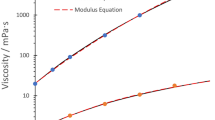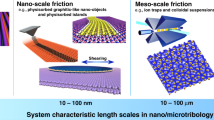Abstract
THE theoretical predictions of Dowson and Higginson1 concerning the size of the lubricant film generated in rolling-bearing line contacts have been adequately confirmed over a fairly large range of pressures and for a wide selection of temperatures, speeds and fluids (see, for example, ref. 2). The theory has been extended to include point and elliptical contact conditions3–5 and various aspects of non-Newtonian fluid behaviour (see, for example, ref. 6). Lately, however, there has been a need to test the predictions at much higher pressures as the loading in modern bearings constantly increases. Since optical elastohydrodynamic techniques7,8 have been limited to a pressure of about 7×108 N m−2 (100,000 pound inch−2) by the use of glass as one lubricated element, this investigation has largely fallen to the X-ray method9. This technique has been doubted by some workers although it has generally reaffirmed the data obtained with earlier methods of film thickness measurement. Unfortunately, recent results10 with this method differ greatly from theory. Film thicknesses have been found an order of magnitude below predicted values at pressures of 2×109 N m−2, and the dependence on load has been generally too great. It is therefore uncertain whether this is a failure of the Dowson and Higginson type of theory or of the X-ray method itself.
This is a preview of subscription content, access via your institution
Access options
Subscribe to this journal
Receive 51 print issues and online access
$199.00 per year
only $3.90 per issue
Buy this article
- Purchase on Springer Link
- Instant access to full article PDF
Prices may be subject to local taxes which are calculated during checkout
Similar content being viewed by others
References
Dowson, D., and Higginson, G. R., Engineering, Lond., 192, 158 (1961).
Dyson, A., Naylor, H., and Wilson, A. R., Proc. Instn. mech. Engrs (EHL Symp.), 180, (Pt 3B), 119 (1965–66).
Archard, J. F., and Cowking, E. W., Proc. Instn. mech. Engrs (EHL Symp.), 180, (Pt. 3B), 47 (1965–66).
Cameron, A., and Gohar, R., Proc. R. Soc., A 1966. 291, 520.
Cheng, H. S., Trans. Am. Soc. Mech. Engrs, Series F (J. Lub. Technol.) 92, 155 (1969).
Kannel, J. W., and Walowit, J. A., Trans. Am. Soc. Mech. Engrs, Series F (J. Lub. Technol.) 93, 39 (1971).
Foord, C. A., Wedeven, L. D., Westlake, F. J., and Cameron, A., Proc. Instn. mech. Engrs, 184, (Pt. 1) 487 (1969–70).
Snidle, R. W., and Archard, J. P., Proc. Instn. mech. Engrs (EHL Symp.), paper C2 (1972).
Bell, J. C., and Kannel, J. W., Trans. Am. Soc. Mech. Engsr, Series F (J. Lub. Technol.) 92, 1 (1970).
Parker, R. J., and Kannel, J. W., NASA TN D-6411 (NASA, 1971).
Paul, G. R., and Cameron, A., Proc. R. Soc., A 331, 171 (1972).
Author information
Authors and Affiliations
Rights and permissions
About this article
Cite this article
GENTLE, C., CAMERON, A. Optical Elastohydrodynamics at Extreme Pressures. Nature 246, 478–479 (1973). https://doi.org/10.1038/246478a0
Received:
Revised:
Issue Date:
DOI: https://doi.org/10.1038/246478a0
This article is cited by
-
A time-dependent reliability analysis method for bearing lubrication
Structural and Multidisciplinary Optimization (2020)
Comments
By submitting a comment you agree to abide by our Terms and Community Guidelines. If you find something abusive or that does not comply with our terms or guidelines please flag it as inappropriate.



